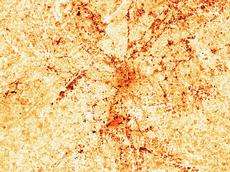Soon more heat stress in cities?

(PhysOrg.com) -- For the first time, scientists have conducted a global study of the effects persistent heatwaves can have on cities. The results reveal that the frequency of summer heat stress could increase more sharply in cities than in the surrounding rural areas.
Tens of thousands of people died from the heat and its indirect effects (particularly air pollution caused by forest fires) as a result of the heatwaves in Europe (2003) and Russia (2010). People in cities were most affected. The reason is that – aside from the high population density – cities cool down less at night compared to the surrounding rural areas. Urban structures store additional heat in the daytime and, as there is often a lack of green spaces, less evaporates. The heat becomes trapped in the high-rise canyons, which means the city cools down to a lesser extent than the surrounding rural areas. Cities thus become local heat islands.
Not factored into climate models
Although cities thus have a considerable influence on the climate, they are not explicitly taken into consideration in the models. “Globally speaking, cities cover a small area that only has a minor impact on the average global temperatures,” explains ETH-Zurich climate researcher Erich Fischer, first author of the study on the development of heat stress in cities published in Geophysical Research Letters.
Due to the effects of the 2003 and 2010 heatwaves and the fact that over half of the world’s population already lives in cities, Fischer, together with climate scientists from the National Center for Atmospheric Research in Boulder, Colorado, has now taken into consideration urban heat stress in global climate models for the first time. Previously, there had only been models for specific cities. The new scenarios offer an outlook on how climate change might affect cities and thus the health of their population.
The model simulations used a grid spaced at about 100 kilometres. As cities often only cover an area of a few square kilometres, the researchers used satellite images to subdivide each grid box into the corresponding proportions of forest, grassland, water or built-up areas. They used the diurnal cycle of apparent temperature to determine the extent of the heat stress based on a combination of the temperature and humidity in the atmosphere near the ground. On this basis, the scientists simulated how heat stress develops in cities compared to the surrounding countryside over hours and days.
Sharp urban-rural contrast
The simulations reveal that distinctive urban heat islands develop during heatwaves in Europe, North America and Asia, especially in the subtropics. The result is also consistent with numerous actual measurements, as Fischer stresses. The urban-rural contrast increases significantly in these regions, especially at night. The modelling also shows that the temperature compared to the atmospheric humidity is the key factor for the high levels of heat stress in cities. “Although the dry air in cities compensates slightly for the temperature surplus, it is not enough to even out the urban-rural heat stress difference,” says Fischer.
In the tropics, the models did not show a contrast between cities and the surrounding rural areas. “This is also confirmed by measurements conducted in case studies”, says Fischer. According to the scientist, the reason for the lack of contrast is that the moist tropical soils differ less from cities in terms of their heat capacity and conduction than outside the tropics. Furthermore, there is a high level of humidity in both cities and the surrounding rural areas, and the clouds cause less heat to be radiated off.
No rest at night
When the scientists doubled the CO2 content in their models by way of an experiment, the city and countryside warmed up more or less equally in all climes. “That’s reassuring, for if cities were to warm up considerably more intensely, it would have been particularly alarming,” stresses Fischer. However, in doubling the CO2 content in the atmosphere, it became apparent that the number of “nights with high heat stress” rises more sharply in cities than in the surrounding rural areas and thus the health risk for city dwellers increases significantly. It is hard for the human body, which produces about 100 watts (joules per second) of heat, to give off its heat into the surroundings in temperatures close to the body’s own. And if there is also high humidity, it becomes harder to cool down as the cooling evaporation of sweat no longer works.
Fischer concedes that the study is a macroscale, rough estimation, through which no local assertions could be made for individual cities. According to Fischer, the study is chiefly aimed at providing an incentive to conduct more research in this direction in order to be able to adopt suitable measures for adaptation.
More information: Fischer EM, Oleson KW & Lawrence DM: Contrasting urban rural heat stress responses to climate change, Geophys. Res. Lett. (2012), 39, L03705, doi: 10.1029/2011GL050576
Journal information: Geophysical Research Letters
Provided by ETH Zurich













